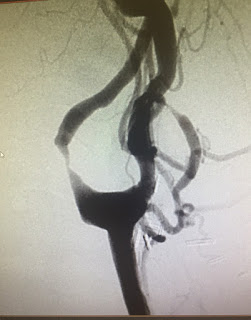Laryngectomees are more susceptible to
some respiratory infections because the air they inhale is not filtered by
passing through their nose. Consequently, they are at an increased risk of
inhaling respiratory pathogens (viruses, bacteria, and fungi) directly into
their lungs.
Laryngectomees are also at high risk for
poor outcomes when contracting COVID-19 because of their propensity to suffer from
collapse of the lower lobs of their lungs (atelectasis). This is due to loss of
upper airway resistance and impaired mucociliary functions, and mucosal
irritation from cold, or dry inspired air. Further comorbidities such as
advanced age, chronic disease (pulmonary, peripheral vascular, cardiac,
cerebrovascular), diabetes, and past smoking, increase this risk.
Therefore, laryngectomees have to be vigilant
and protect themselves from becoming infected with COVID-19. This can be done
by wearing eat and mosuture exchanger (HME) with greater filtering properties (
i.e., Provox Micron TM); using 2 surgical masks (preferably N95), one over the
stoma and the other over the mouth and nose; staying at least 6 feet away from
others; washing hands often with soap and water for at least 20 seconds; and
not touching their stoma, HME, eyes, nose, and mouth with unwashed hands.
Laryngectomees can protect themselves by receiving
vaccination against COVID-19. All COVID-19 vaccines currently available in the
United States have been shown to be highly effective at preventing COVID-19.
Based on clinical trials, experts believe that getting a COVID-19 vaccine may
also help keep one from getting seriously ill even when one get infected with COVID-19.
Becoming vaccinated may also protect people around the vaccinated person,
particularly those at increased risk for severe illness from COVID-19. This
also contributes to the curbing of the national and world pandemic.
Among the benefits of being vaccinated is
the emotional relief of gaining protection from the virus, and the ability of
feel safer in face to face social interactions and when seeking medical and
dental care.
Clinical trials demonstrated that the
known and potential benefits of these vaccine outweigh the their side effects,
and the known and potential harms of becoming infected with COVID-19. The Center
for Disease Control’s (CDC) has reported that severe allergic reactions to
COVID-19 vaccines are very rare and happened at a rate of 11.1 cases per
million vaccinations.
Vaccination is not expected to relax the CDC
recommendations for continued use of masks and social distancing. This is
because vaccines are not 100% effective, their protective effect is not maximized
for at least six weeks, and vaccines may keep a person from getting sick but
not from transmitting the virus. Masks and HMEs reduce the spread of any
mutated strain of the coronavirus, while vaccines may not be as effective in
preventing the transmission of newer, more contagious strains.
It is advisable to contact one’s
physicians for guidance about vaccination or if one gets ill with the Corona
virus. There are currently treatments available that can be administered early
in the course of the infection to mitigate the illness and prevent
complications. It would be prudent to following the guidance and instruction issued
by the CDC and the local government health authorities.






























